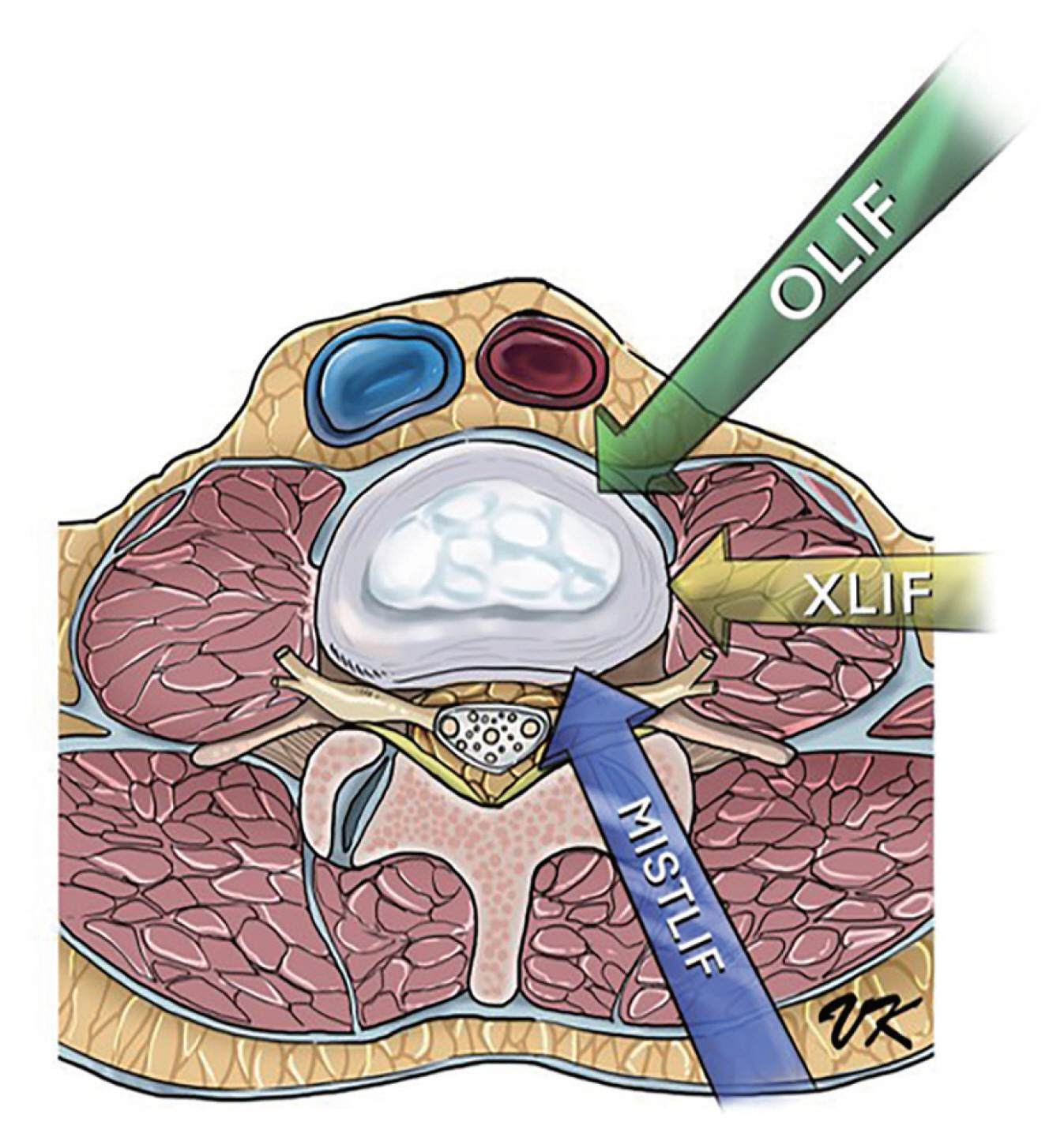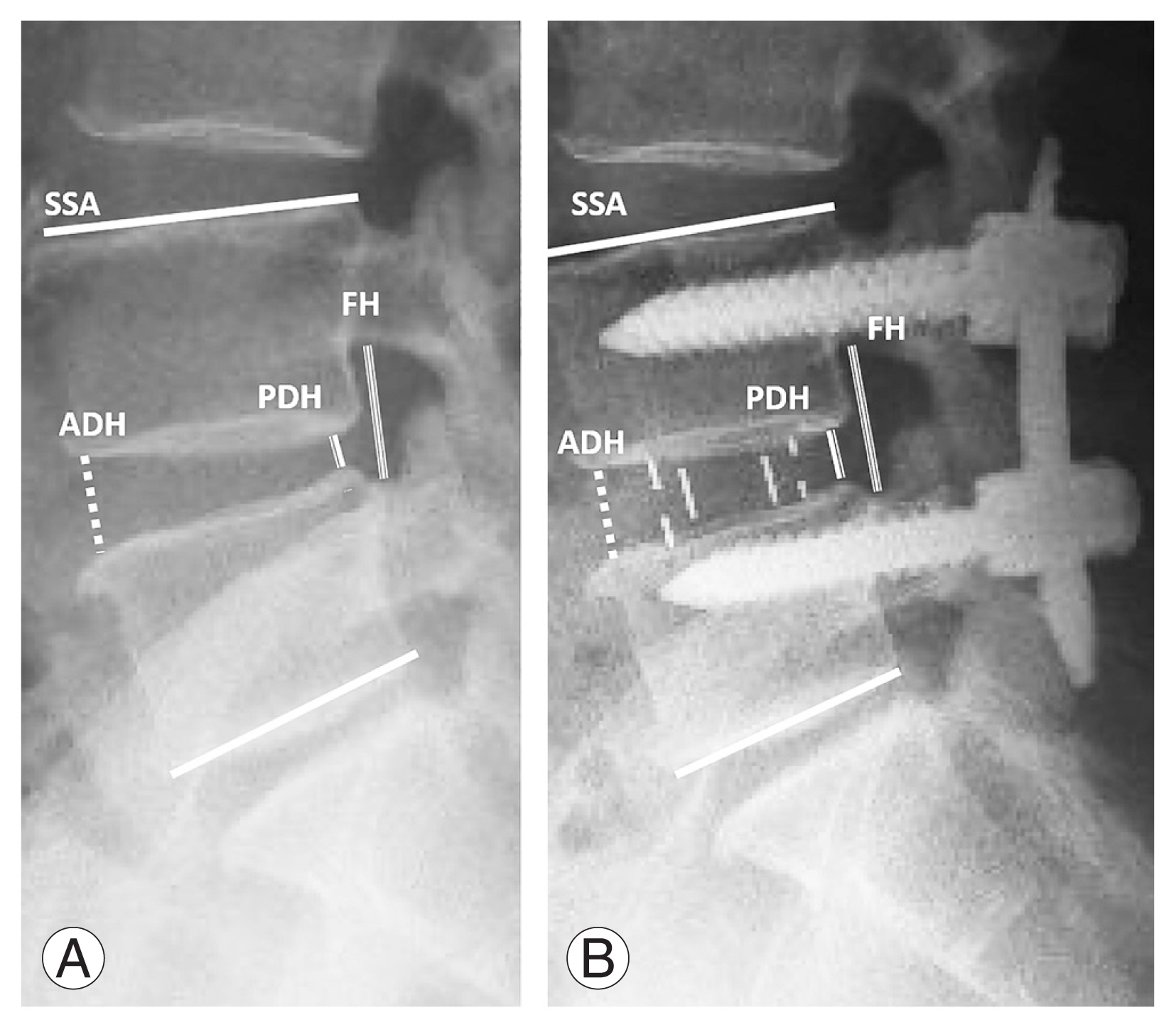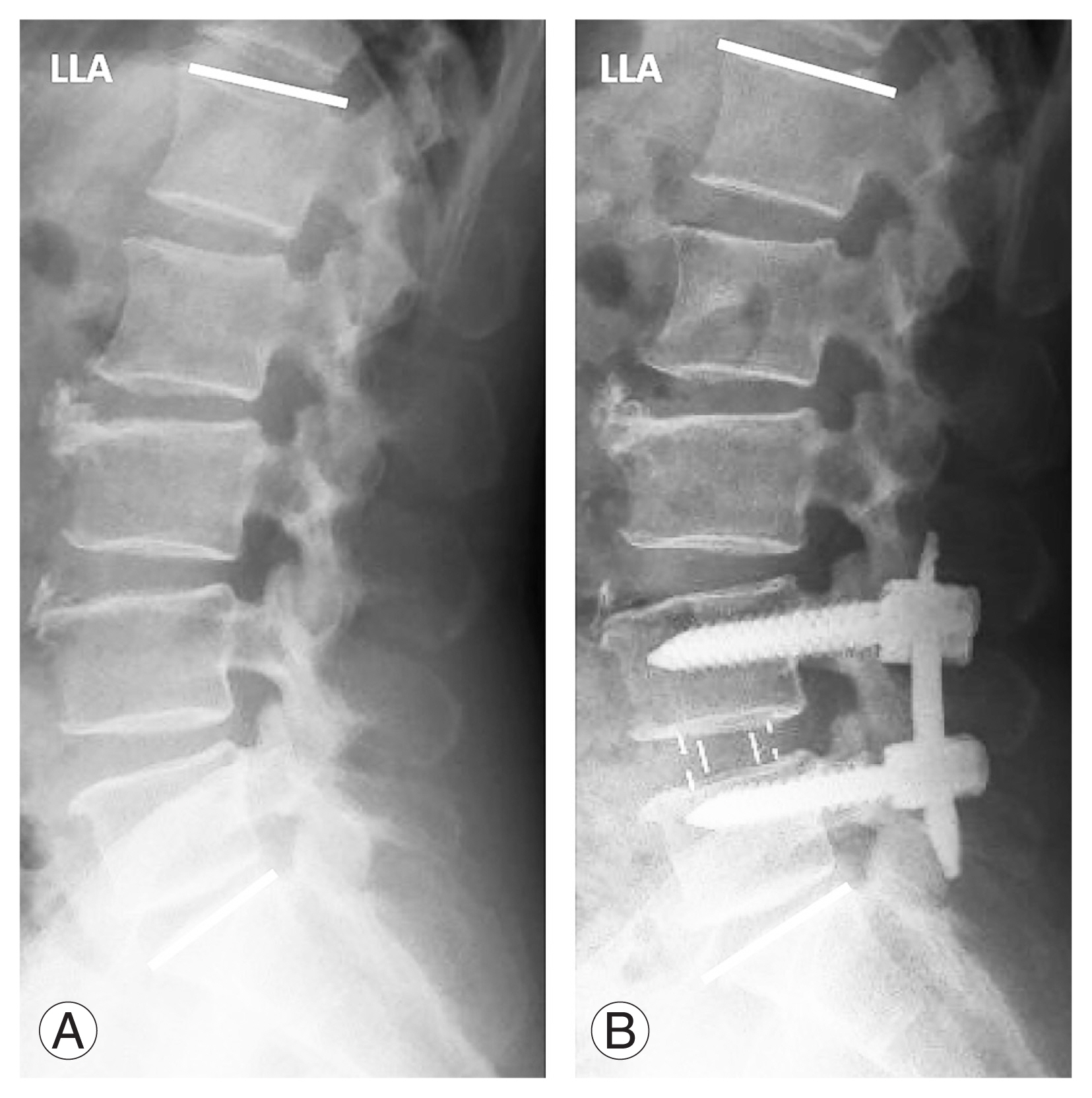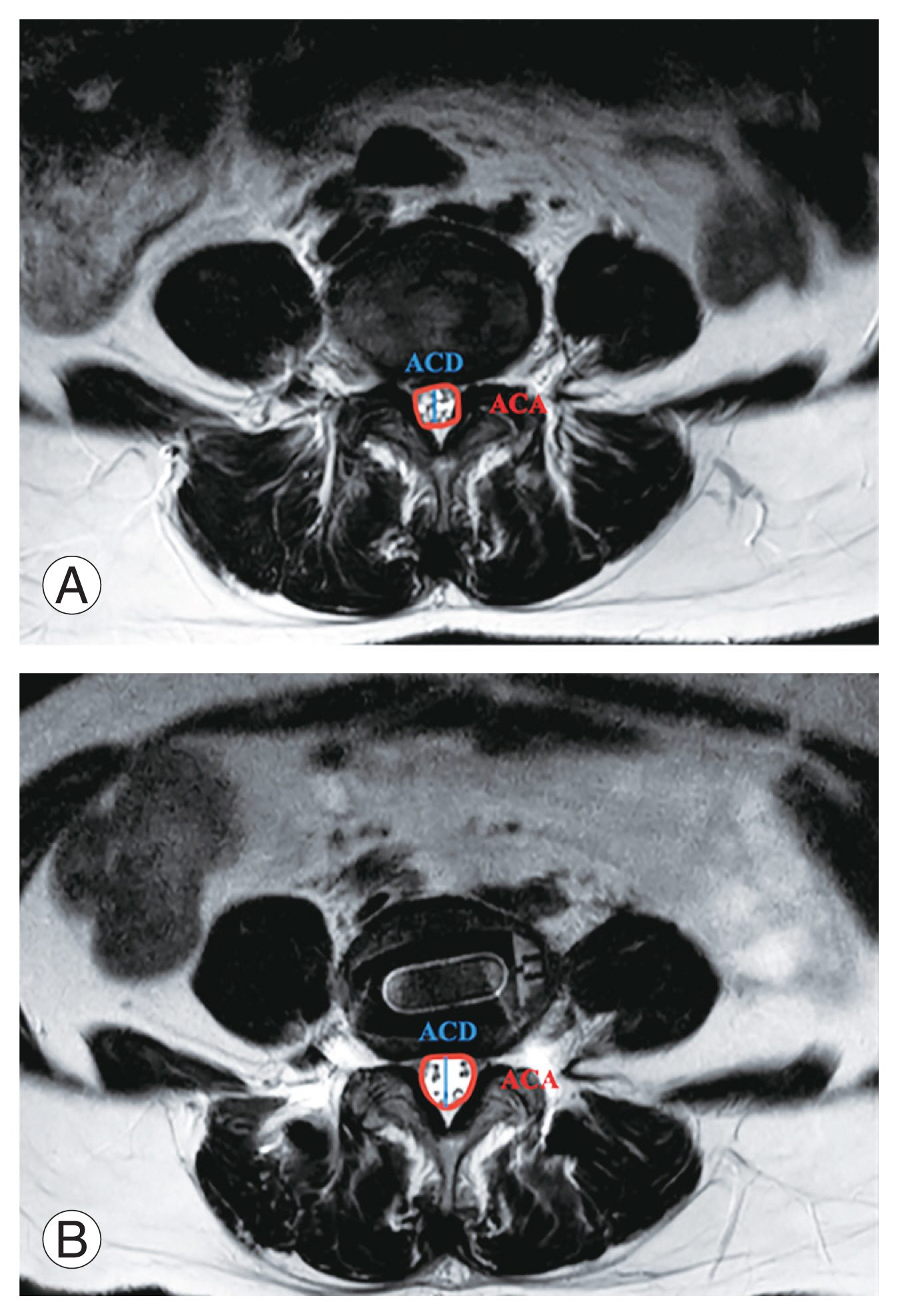 |
 |
- Search
| Asian Spine J > Volume 16(5); 2022 > Article |
|
Abstract
Purpose
Overview of Literature
Methods
Results
Conclusions
Acknowledgments
Notes
Author Contributions
Wicharn Yingsakmongkol: conceptualization, resources; Khanathip Jitpakdee: data collection; Panapol Varakornpipat: data collection, writing (original draft); Chitapoom Choentrakool: data analysis; Teerachat Tanasansomboon: writing (review and editing); Worawat Limthongkul: supervision, resources; Weerasak Singhatanadgige: methodology, resources; Vit Kotheeranurak: writing (review and editing), supervision.
Fig. 1

Fig. 2

Fig. 3

Fig. 4

Table 1
Table 2
| Variable | MIS-TLIF (n=30) | XLIF (n=30) | OLIF (n=30) | p-valuea) | Multiple comparisons by Bonferroni test | ||
|---|---|---|---|---|---|---|---|
| M vs. X | M vs. O | X vs. O | |||||
| Duration of hospital stay (day) | 4.33±0.61 | 3.6±0.62 | 3.7±0.53 | <0.001b) | <0.001b) | <0.001b) | 1 |
| Operation | |||||||
| Operative time (hr) | 2.82±0.47 | 2.4±0.81 | 2.53±0.51 | 0.03 | 0.029b) | 0.218 | 1 |
| Estimated blood loss (mL) | 200.33±59.22 | 49.17±32.91 | 48.67±33.4 | <0.001b) | <0.001b) | <0.001b) | 1 |
| Complication | |||||||
| No | 30 (100.0) | 28 (93.3) | 27 (90.0) | 0.384 | 0.150 | 0.206 | 0.601 |
| Deep vein thrombosis | 0 | 0 | 1 (3.3) | ||||
| Thigh pain | 0 | 2 (6.7) | 0 | ||||
Table 3
| Variable | MIS TLIF (n=30) | XLIF (n=30) | OLIF (n=30) | p-valuea) | Multiple comparisons by Bonferroni | ||
|---|---|---|---|---|---|---|---|
| M vs. X | M vs. O | X vs. O | |||||
| VAS (back) | |||||||
| Preoperative | 8.2±1.42 | 7.93±1.28 | 8.4±1.5 | 0.438 | 1 | 1 | 0.606 |
| 1 mo | 1.63±2.24 | 1.6±1.61 | 1.8±2.33 | 0.924 | 1 | 1 | 1 |
| 3 mo | 0.67±1.65 | 0.77±1.43 | 0.83±1.29 | 0.906 | 1 | 1 | 1 |
| 6 mo | 0.3±1.06 | 0.4±1.1 | 0.4±1.16 | 0.922 | 1 | 1 | 1 |
| 1 yr | 0.1±0.55 | 0.47±1.11 | 0.1±0.55 | 0.116 | 0.216 | 1 | 0.216 |
| Difference of 1 mo | −6.57 (−7.6 to −5.54)b) | −6.33 (−6.9 to −5.77)b) | −6.6 (−7.56 to −5.64)b) | 0.892 | 1 | 1 | 1 |
| Difference of 3 mo | −7.53 (−8.25 to −6.82)b) | −7.17 (−7.87 to −6.46)b) | −7.57 (−8.22 to −6.91)b) | 0.652 | 1 | 1 | 1 |
| Difference of 6 mo | −7.9 (−8.53 to −7.27)b) | −7.53 (−8.16 to −6.91)b) | −8 (−8.63 to −7.37)b) | 0.530 | 1 | 1 | 0.857 |
| Difference of 1 yr | −8.1 (−8.72 to −7.48)b) | −7.47 (−8.08 to −6.85)b) | −8.3 (−8.86 to −7.74)b) | 0.117 | 0.391 | 1 | 0.143 |
| VAS (leg) | |||||||
| Preoperative | 7.87±2.1 | 7.7±0.99 | 7.7±1.76 | 0.907 | 1 | 1 | 1 |
| 1 mo | 1±1.34 | 1.37±2.33 | 1.63±2.22 | 0.475 | 1 | 0.678 | 1 |
| 3 mo | 0.63±1.38 | 0.77±1.83 | 0.3±1.15 | 0.457 | 1 | 1 | 0.676 |
| 6 mo | 0.57±1.43 | 0.5±1.59 | 0.2±0.66 | 0.508 | 1 | 0.826 | 1 |
| 1 yr | 0.2±0.81 | 0.47±1.48 | 0.03±0.18 | 0.229 | 0.882 | 1 | 0.269 |
| Difference of 1 mo | −6.87 (−7.85 to −5.89)b) | −6.33 (−7.22 to −5.44)b) | −6.07 (−7.18 to −4.95)b) | 0.502 | 1 | 0.751 | 1 |
| Difference of 3 mo | −7.23 (−8.22 to −6.24)b) | −6.93 (−7.61 to −6.26)b) | −7.4 (−8.21 to −6.59)b) | 0.716 | 1 | 1 | 1 |
| Difference of 6 mo | −7.3 (−8.3 to −6.3)b) | −7.2 (−7.87 to −6.53)b) | −7.5 (−8.21 to −6.79)b) | 0.861 | 1 | 1 | 1 |
| Difference of 1 yr | −7.67 (−8.53 to −6.8)b) | −7.23 (−7.9 to −6.57)b) | −7.67 (−8.33 to −7.01)b) | 0.619 | 1 | 1 | 1 |
| ODI | |||||||
| Preoperative | 53.4±16.56 | 52.68±18.85 | 52.98±17.88 | 0.988 | 1 | 1 | 1 |
| 1 mo | 15.16±18.21 | 21.74±20.98 | 11.49±14.44 | 0.090 | 0.486 | 1 | 0.092 |
| 3 mo | 6.93±15.31 | 12.73±16.75 | 7.35±15.67 | 0.296 | 0.486 | 1 | 0.584 |
| 6 mo | 2.22±7.9 | 5.47±10.87 | 3.06±7.47 | 0.342 | 0.478 | 1 | 0.882 |
| 1 yr | 0±0 | 3.13±8.24 | 0.22±1.22 | 0.023b) | 0.040b) | 1 | 0.063 |
| Difference of 1 mo | −38.24 (−48.18 to −28.31)b) | −30.94 (−42.24 to −19.64)b) | −41.49 (−50.06 to −32.92)b) | 0.300 | 0.881 | 1 | 0.392 |
| Difference of 3 mo | −46.47 (−55.48 to −37.47)b) | −39.95 (−50.56 to −29.35)b) | −45.63 (−54.49 to −36.76)b) | 0.562 | 0.975 | 1 | 1 |
| Difference of 6 mo | −51.18 (−58.3 to −44.06)b) | −47.21 (−55.9 to −38.51)b) | −49.92 (−56.97 to −42.88)b) | 0.746 | 1 | 1 | 1 |
| Difference of 1 yr | −53.4 (−59.59 to −47.22)b) | −49.65 (−57.64 to −41.67)b) | −52.76 (−59.66 to −45.85)b) | 0.715 | 1 | 1 | 1 |
MIS-TLIF, minimally invasive transforaminal lumbar interbody fusion; XLIF, extreme lateral lumbar interbody fusion; OLIF, oblique lateral lumbar interbody fusion; M vs. X, MIS-TLIF vs. XLIF; M vs. O, MIS-TLIF vs. OLIF; X vs. O, XLIF vs. OLIF; VAS, Visual Analog Scale; ODI, Oswestry Disability Index.
Table 4
| Variable | MIS TLIF (n=30) | XLIF (n=30) | OLIF (n=30) | p-valuea) | Multiple comparisons by Bonferroni test | ||
|---|---|---|---|---|---|---|---|
| M vs. X | M vs. O | X vs. O | |||||
| Anterior disc height (mm) | |||||||
| Preop | 8.36±2.83 | 7.37±2.22 | 9.11±3.17 | 0.056 | 0.510 | 0.893 | 0.051 |
| Postop | 10.24±2.4 | 15.05±2.33 | 14.6±1.96 | <0.001b) | <0.001b) | <0.001b) | 1 |
| Mean difference (95% CI) | 1.88 (1.08 to 2.68)b) | 7.68 (6.89 to 8.47)b) | 5.49 (4.41 to 6.57)b) | <0.001b) | <0.001b) | <0.001b) | 0.002b) |
| %Change postop | 28.3% | 115% | 79.8% | <0.001b) | <0.001b) | <0.001b) | 0.022b) |
| Posterior disc height (mm) | |||||||
| Preop | 6.98±1.45 | 6.44±1.21 | 7.32±2.11 | 0.119 | 0.616 | 1 | 0.124 |
| Postop | 8.64±1.48 | 13.06±2.48 | 12.72±2.19 | <0.001b) | <0.001b) | <0.001b) | 1 |
| Mean difference (95% CI) | 1.67 (1.3 to 2.03)b) | 6.62 (5.73 to 7.5)b) | 5.4 (4.31 to 6.49)b) | <0.001b) | <0.001b) | <0.001b) | 0.114 |
| %Change postop | 26% | 107% | 87.1% | <0.001b) | <0.001b) | <0.001b) | 0.227 |
| Foraminal height (mm) | |||||||
| Preop | 15.35±1.77 | 14.7±2.59 | 14.33±2.49 | 0.229 | 0.852 | 0.272 | 1 |
| Postop | 16.95±2.12 | 19.03±2.46 | 20.32±3.25 | <0.001b) | 0.009 | <0.001b) | 0.191 |
| Mean difference (95% CI) | 1.6 (0.67 to 2.53)b) | 4.33 (3.32 to 5.34)b) | 5.99 (4.91 to 7.08)b) | <0.001b) | 0.001 | <0.001b) | 0.058 |
| %Change postop | 11.5% | 31.9% | 44.1% | <0.001b) | 0.001b) | <0.001b) | 0.1 |
| Segmental sagittal angle (°) | |||||||
| Preop | 10.6±5.93 | 8.7±5.4 | 11.73±6.67 | 0.160 | 0.396 | 1 | 0.227 |
| Postop | 12.8±6 | 10.23±6.3 | 13.27±7.25 | 0.149 | 0.675 | 1 | 0.163 |
| Mean difference (95% CI) | 2.2 (−0.27 to 4.13)b) | 1.53 (−0.28 to 3.34) | 1.53 (−0.46 to 3.53) | 0.844 | 1 | 1 | 1 |
| %Change postop | 12.8% | 2.2% | 9.1% | 0.592 | 1 | 0.955 | 1 |
| Lumbar lordotic angle (°) | |||||||
| Preop | 30.63±13.01 | 26.2±12.8 | 25.97±13.69 | 0.307 | 0.587 | 0.521 | 1 |
| Postop | 34.5±10.07 | 27.13±11.92 | 27.77±11.96 | 0.024b) | 0.041b) | 0.072 | 1 |
| Mean difference (95% CI) | 3.87 (0.86 to 6.88)b) | 0.93 (−1.21 to 3.08) | 1.8 (−0.44 to 4.04) | 0.223 | 0.278 | 0.703 | 1 |
| %Change postop | 24.2% | 29.2% | 47.7% | 0.693 | 1 | 1 | 1 |
| Axial canal area (mm2) | |||||||
| Preop | 46.79±27.94 | 76.85±44.33 | 66.83±32.55 | 0.005b) | 0.005b) | 0.096 | 0.836 |
| Postop | 145.52±41.46 | 137.4±48.22 | 122.24±46.3 | 0.137 | 1 | 0.151 | 0.599 |
| Mean difference (95% CI) | 98.73 (84.45 to 113)b) | 60.55 (51.55 to 69.54)b) | 55.42 (43.31 to 67.52)b) | <0.001b) | <0.001b) | <0.001b) | 1 |
| %Change postop | 390.4% | 113.6% | 95.5% | <0.001b) | <0.001b) | <0.001b) | 1 |
| Axial canal diameter (mm) | |||||||
| Preop | 6.99±2.57 | 8.4±2.53 | 8.42±2.73 | 0.057 | 0.117 | 0.112 | 1 |
| Postop | 11.78±2.08 | 11.67±2.36 | 12.05±2.96 | 0.838 | 1 | 1 | 1 |
| Mean difference (95% CI) | 4.79 (3.84 to 5.75)b) | 3.27 (2.7 to 3.84)b) | 3.63 (3.04 to 4.22)b) | 0.009b) | 0.010b) | 0.05b) | 1 |
| %Change postop | 98.1% | 44.5% | 48.3% | 0.003b) | 0.007b) | 0.013b) | 1 |
Values are presented as mean±standard deviation or difference (95% confidence interval), unless otherwise stated.
MIS-TLIF, minimally invasive transforaminal lumbar interbody fusion; XLIF, extreme lateral lumbar interbody fusion; OLIF, oblique lateral lumbar interbody fusion; M vs. X, MIS-TLIF vs. XLIF; M vs. O, MIS-TLIF vs. OLIF; X vs. O, XLIF vs. OLIF; Preop, preoperative; Postop, postoperative; CI, confidence interval.






